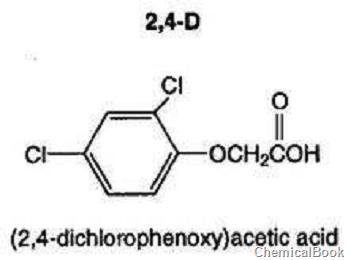Background[1-3]
2,4-Dichlorophenoxyacetic acid (2,4-D) is a common systemic herbicide used to control broadleaf weeds. It is the most widely used herbicide in the world and the third most used in North America. 2,4-D is also an important synthetic auxin, commonly used in laboratories for plant research and as a supplement to plant cell culture media (such as MS media). 2,4-D is a synthetic auxin, a type of plant growth regulator. It is absorbed through the leaves and transferred to the meristem of the plant. What ensues is uncontrolled, unsustainable growth, causing stems to curl, leaves to wilt and ultimately the plant to die. 2,4-D is commonly used in the form of amine salts, but more potent ester versions also exist. At low concentrations (10 to 50 ppm), 2,4-D can prevent flower and fruit drop, increase fruit setting rate, promote fruit growth, ripen earlier, and increase yield.

Apply[4][5]
Research on rapid immunological detection technology of 2,4-dichlorophenoxyacetic acid
2,4-Dichlorophenoxyacetic acid (2,4-D) is a commonly used plant growth regulator and herbicide, and is widely used to improve fruit quality and extend shelf life. However, due to its It is not easy to degrade, resulting in a large number of residues in nature, causing serious harm to our ecological environment and human health. 2,4-Dichlorophenoxyacetic acid can enter the body through the skin and respiratory system. It is potentially carcinogenic and mutagenic. It can stimulate the body to secrete a large amount of estrogen, interfere with the endocrine system, and have adverse effects on the reproductive and immune systems. Influence. In addition, 2,4-dichlorophenoxyacetic acid can also cause red blood cells to aggregate, hinder the oxygen-carrying capacity of red blood cells, damage muscles, liver, kidneys and brain tissue, and also cause damage to our eyes, skin and mucous membranes. .
The artificial antigens 2,4-D-BSA and 2,4-D-OVA were prepared, and 2,4-dichlorophenoxyacetic acid artificial immunization antigen was used to immunize BALB/c pure-line mice to obtain specific polypeptides. Antibodies were cloned, and monoclonal antibodies were prepared using hybridoma cell technology. A 2,4-dichlorophenoxyacetic acid indirect competition ELISA kit was assembled and its performance was evaluated. The main research contents and results are as follows: 1. Preparation and identification of 2,4-dichlorophenoxyacetic acid artificial antigen using carbodiimide method (EDC method) to combine 2,4-dichlorophenoxyacetic acid with bovine serum albumin (BSA) and ovalbumin (OVA) coupling, synthesis of immunogen 2,4-D-BSA and coating agent 2,4-D-OVA, using ultraviolet scanning (UV) and polyacrylamide gel electrophoresis (SDS-PAGE) Method for identification; 2,4-dichlorophenoxyacetic acid artificial immune antigen (2,4-D-BSA) was used to immunize BALB/c pure strain mice, and the titer of mouse polyantiserum was determined by indirect ELISA and blocking ELISA Identify its inhibition.
The results show that after the coupling of BSA and 2,4-dichlorophenoxyacetic acid, the wave peak shifts to the right, indicating that the coupling is successful; the swimming speed of BSA in SDS-PAGE electrophoresis is greater than that of 2,4-D-BSA. 2,4-Dichlorophenoxyacetic acid has been successfully coupled to BSA; the serum titers of 6 mice all reached 1:1.28×104, and the No. 1 mouse polyantiserum has the best sensitivity, with a half inhibition IC50 of 72.48ng /mL, indicating that the mouse anti-2,4-dichlorophenoxyacetic acid polyclonal antibody serum with high titer, good specificity and high affinity was successfully obtained, which is an immunological detection method for 2,4-dichlorophenoxyacetic acid residues. The establishment laid a good foundation.
References
[1]Development of immunoassays for the detection of sulfamethazine in swine urine[J]. ,Shujun Cai,Huanchun Chen.Food Additives&Contaminants:Part A.2009(3)
[2]Development of a lateral flow immunoassay strip for screening of sulfamonomethoxine residues[J].G.Zhang,X.Wang,A.Zhi,Y.Bao,Y.Yang,M.Qu,J.Luo, Q.Li,J.Guo,Z.Wang,J.Yang,G.Xing,S.Chai,T.Shi,Q.Liu.Food Additives&Contaminants:Part A.2007(4)
[3]Enzyme-linked immunosorbent assay and colloidal gold immunoassay for ochratoxin A: investigation of analytical conditions and sample matrix on assay performance[J].Xiang-Hong Wang,Tao Liu,Na Xu,Yan Zhang,Shuo Wang. Analytical and Bioanalytical Chemistry.2007(3)
[4]Development of an immunochromatographic lateral flow test strip for detection ofβ-adrenergic agonist Clenbuterol residues[J].G.P.Zhang,X.N.Wang,J.F.Yang,Y.Y.Yang,G.X.Xing,Q.M.Li,D.Zhao,S.J.Chai ,J.Q.Guo.Journal of Immunological Methods.2006(1)
[5]Gong Fang. Research on rapid immunological detection technology of 2,4-dichlorophenoxyacetic acid[D]. Henan University of Technology, 2013.



 微信扫一扫打赏
微信扫一扫打赏
